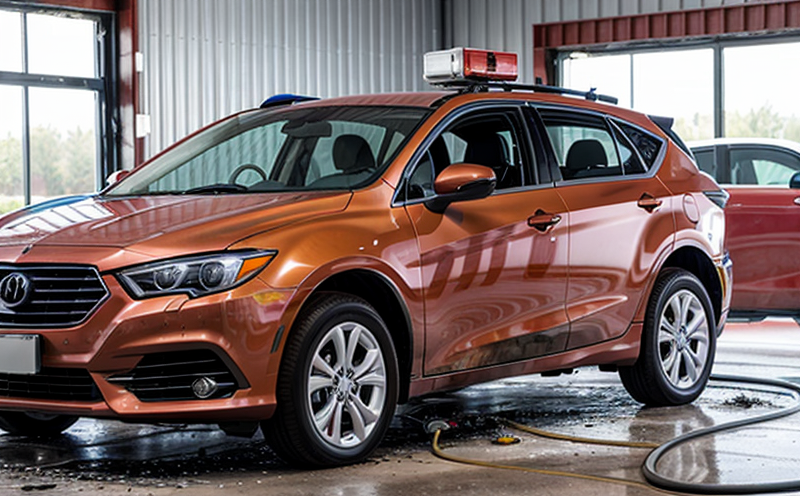Heat Release Rate Testing of Automotive Interior Materials
The heat release rate (HRR) testing is a critical method used to evaluate the flammability characteristics of automotive interior materials. This test assesses the amount of heat released by a material during combustion, providing insight into its fire resistance and potential for self-extinguishing behavior.
In the context of automotive interiors, HRR testing ensures that materials meet stringent safety standards, contributing to occupant protection in case of a fire event. The test is particularly important given the high volume of combustible materials present within vehicles, such as upholstery, seat covers, and trim materials. These materials can ignite easily and spread flames quickly if not properly designed.
The HRR testing process involves placing a standard-sized specimen of the material under controlled combustion conditions. A calorimeter measures the heat output during burning, providing data on the maximum heat release rate (MJ/kg) and other critical parameters like peak heat release rate (PHRR).
Compliance with international standards such as ISO 56602, ASTM E678, and EN 13501-1 is essential for manufacturers to ensure their products meet the required safety levels. These standards provide detailed protocols on specimen preparation, test setup, and data interpretation.
Accurate testing of HRR is vital not only for regulatory compliance but also for enhancing vehicle safety. By identifying materials with higher HRR values early in the design process, engineers can explore alternative options that are less likely to contribute to a fire hazard. Additionally, this testing helps in optimizing flame retardant additives and improving overall material performance.
The significance of HRR testing extends beyond mere compliance; it also plays a crucial role in reducing insurance premiums for vehicle owners who opt for safer interior materials. Insurance companies often consider the fire risk associated with vehicle interiors when determining premium rates, making HRR data an important factor.
Understanding the intricacies of HRR testing can empower automotive manufacturers and material suppliers to make informed decisions about their product development processes. By incorporating this testing early in the design cycle, they can minimize costly redesigns later on due to non-compliance or poor performance under fire conditions.
- Comprehensive Testing: Ensures materials meet strict flammability standards.
- Data-Driven Decision Making: Provides actionable insights for improving material safety and performance.
- Regulatory Compliance: Meets international standards, ensuring legal compliance.
- Premium Reduction: Helps in lowering insurance premiums for safer materials.
In conclusion, HRR testing is an indispensable tool for automotive manufacturers aiming to enhance the fire safety of their vehicles. By incorporating this vital testing into their product development process, they can ensure not only compliance with regulatory requirements but also contribute significantly towards occupant protection and overall vehicle safety.
Scope and Methodology
The scope of HRR testing for automotive interior materials encompasses a wide range of applications across various sectors within the automotive industry. This includes passenger cars, commercial vehicles, buses, and even motorcycles where appropriate. The methodology involves several key steps that ensure accurate and reliable results:
- Specimen Preparation: Standard-sized specimens are cut from the material to be tested.
- Calorimeter Setup: Specimens are placed in a calorimeter designed specifically for HRR testing. The device measures heat release, oxygen consumption, and other critical parameters.
- Combustion Conditions: Controlled combustion is initiated under specified conditions to simulate real-world fire scenarios.
- Data Collection: The calorimeter records the heat output during burning, providing detailed data on HRR values.
- Data Analysis: Collected data is analyzed against international standards like ISO 56602 and ASTM E678 to determine compliance and performance.
The methodology employed in HRR testing ensures that the results are both accurate and consistent, providing manufacturers with reliable information on material flammability. This standardized approach allows for direct comparison between different materials, facilitating informed decision-making during product design and development.
Benefits
The benefits of conducting HRR testing for automotive interior materials extend far beyond mere compliance; they encompass several key advantages that contribute to enhanced vehicle safety:
- Promotes Safety: Ensures that the materials used in vehicles are less likely to ignite or sustain combustion, thereby reducing the risk of fire.
- Reduces Insurance Costs: Materials that meet strict HRR standards can lead to lower insurance premiums for vehicle owners, as they pose a reduced fire hazard.
- Enhances Reputation: Demonstrating commitment to safety through rigorous testing enhances the reputation and brand image of automotive manufacturers.
- Improves Design Flexibility: Early identification of materials with high HRR values allows for exploration of alternative options that meet design requirements without compromising on safety.
- Ensures Regulatory Compliance: Meeting international standards ensures compliance with regulatory requirements, avoiding potential legal issues and fines.
- Potential Cost Savings: By identifying issues early in the development process, manufacturers can avoid costly redesigns or recalls later on.
- Consumer Trust: Providing evidence of rigorous testing builds consumer trust, fostering a positive relationship with customers.
In summary, HRR testing offers numerous benefits that go beyond just meeting regulatory requirements. It plays a pivotal role in enhancing vehicle safety, reducing costs, and building trust among consumers.





